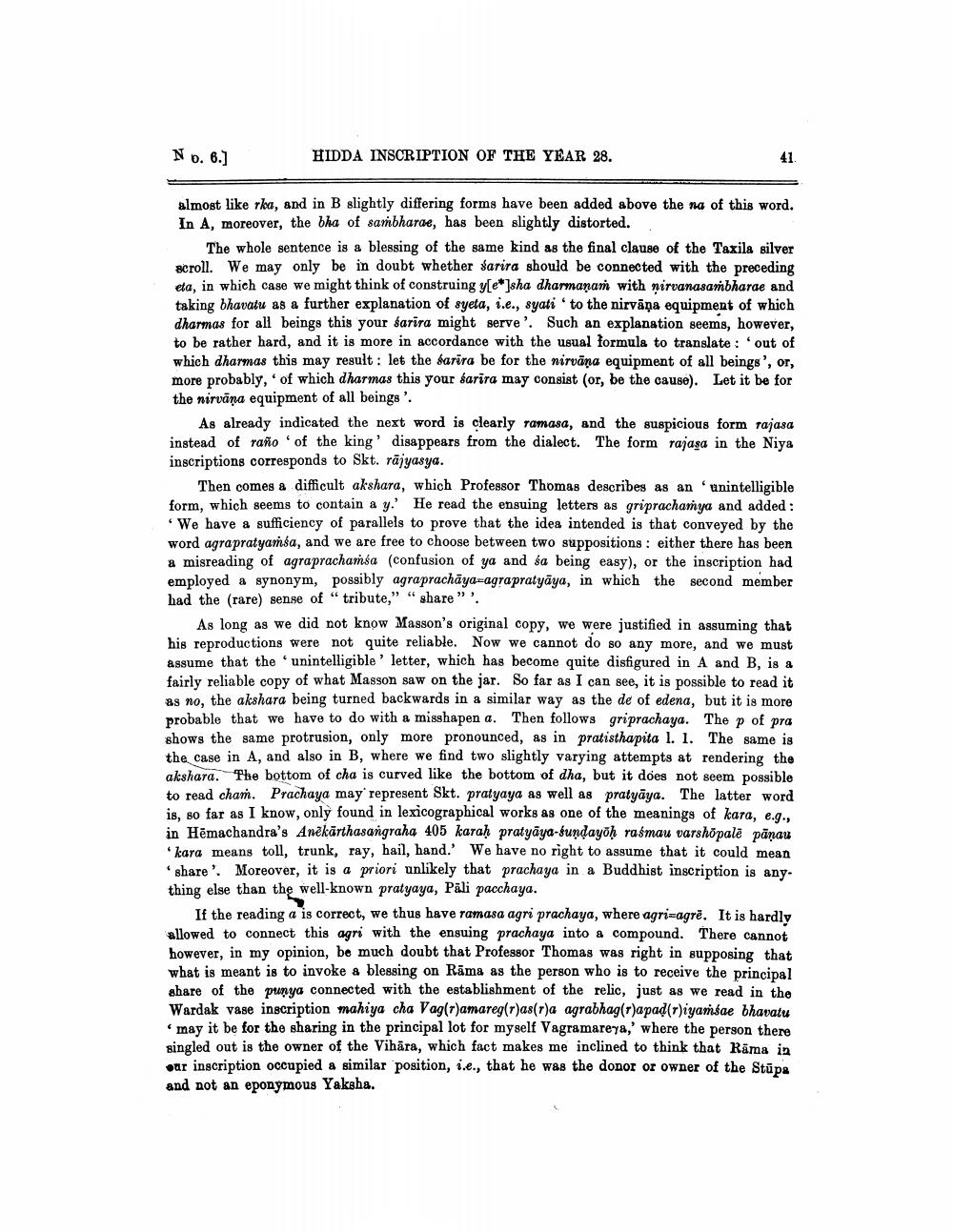________________
No. 6.]
HIDDA INSCRIPTION OF THE YEAR 28.
41.
almost like rka, and in B slightly differing forms have been added above the na of this word. In A, moreover, the bha of sambharae, has been slightly distorted.
The whole sentence is a blessing of the same kind as the final clause of the Taxila silver scroll. We may only be in doubt whether sarira should be connected with the preceding eta, in which case we might think of construing y[e*]sha dharmanam with nirvanasambharae and taking bhavatu as a further explanation of syeta, i.e., syati 'to the nirvana equipment of which dharmas for all beings this your sarira might serve'. Such an explanation seems, however, to be rather hard, and it is more in accordance with the usual formula to translate: out of which dharmas this may result: let the sarira be for the nirvana equipment of all beings', or, more probably, of which dharmas this your sarira may consist (or, be the cause). Let it be for the nirvana equipment of all beings'.
As already indicated the next word is clearly ramasa, and the suspicious form rajasa instead of raño of the king' disappears from the dialect. The form rajasa in the Niya inscriptions corresponds to Skt. rajyasya.
Then comes a difficult akshara, which Professor Thomas describes as an unintelligible form, which seems to contain a y.' He read the ensuing letters as griprachamya and added: 'We have a sufficiency of parallels to prove that the idea intended is that conveyed by the word agrapratyamsa, and we are free to choose between two suppositions: either there has been a misreading of agraprachamsa (confusion of ya and sa being easy), or the inscription had employed a synonym, possibly agraprachāya-agrapratyāya, in which the second member had the (rare) sense of "tribute," "share"".
C
As long as we did not know Masson's original copy, we were justified in assuming that his reproductions were not quite reliable. Now we cannot do so any more, and we must assume that the unintelligible' letter, which has become quite disfigured in A and B, is a fairly reliable copy of what Masson saw on the jar. So far as I can see, it is possible to read it as no, the akshara being turned backwards in a similar way as the de of edena, but it is more probable that we have to do with a misshapen a. Then follows griprachaya. The p of pra shows the same protrusion, only more pronounced, as in pratisthapita 1. 1. The same is the case in A, and also in B, where we find two slightly varying attempts at rendering the akshara. The bottom of cha is curved like the bottom of dha, but it does not seem possible to read cham. Prachaya may represent Skt. pratyaya as well as pratyāya. The latter word is, so far as I know, only found in lexicographical works as one of the meanings of kara, e.g., in Hemachandra's Anekarthasangraha 405 karaḥ pratyaya-sundayöḥ raśmau varshōpalē pānau 'kara means toll, trunk, ray, hail, hand.' We have no right to assume that it could mean 'share'. Moreover, it is a priori unlikely that prachaya in a Buddhist inscription is anything else than the well-known pratyaya, Pāli pacchaya.
If the reading a is correct, we thus have ramasa agri prachaya, where agri-agre. It is hardly allowed to connect this agri with the ensuing prachaya into a compound. There cannot however, in my opinion, be much doubt that Professor Thomas was right in supposing that what is meant is to invoke a blessing on Rama as the person who is to receive the principal share of the punya connected with the establishment of the relic, just as we read in the Wardak vase inscription mahiya cha Vag(r)amareg(r)as(r)a agrabhag(r)apad(r)iyamsae bhavatu
may it be for the sharing in the principal lot for myself Vagramareya,' where the person there singled out is the owner of the Vihara, which fact makes me inclined to think that Rama in our inscription occupied a similar position, i.e., that he was the donor or owner of the Stupa and not an eponymous Yaksha.




